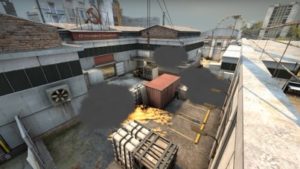When I was in high school, one of my friend group’s favorite games to play on the weekends was Counter-Strike: Global Offensive, more commonly shortened as CS:GO. The game follows a simple formula: two 5-man teams take the role of either attacking or defending specific positions on a map. If a team successfully attacks a site or eliminates all enemy players, they win that round (of which 16 are needed to win the game). The game involves several aesthetic goals, the most prominent of which being its challenge, competition, sensation, and fellowship. For this writing piece, I will examine the goal of fellowship more closely and display how the game’s mechanics and dynamics come together to produce it.
There are several straightforward first-person shooter mechanics at play, such as a recoil-based shooting system, sneaking, grenades, and allied-team voice communications. Each game is played on a single map, where each map has its own unique design related to visibility, verticality, and traversability. CS:GO also has a money system, where players can purchase equipment at the beginning of rounds and earn funds when winning/losing rounds.
The aforementioned mechanics create a fun cooperative team dynamic within rounds. For example, within a round a team may verbally discuss and carry out a plan where 4 members silently sneak as possible to one target site, while the fifth member makes a loud presence at a different site using explosives and weapon fire. Once the defenders move toward the “bait” site, the 4 hidden members can emerge and attack a now-weakened position. The amount of strategies allowed by the basic mechanics is surprising: what if the attackers do a double-fake out? What if the defenders themselves sneak out from their sites and press the attackers’ positions? What if the attackers notice a pattern of where the defenders play each round and use smoke grenades and flashbangs to disrupt visibility from those positions?

Throwing grenades in the right spots can have a powerful effect on visibility and movement.
I haven’t even discussed the economy system and the between-round strategies it can introduce, but I hope that this article has given a good perspective on how a simple competitive game can also promote cooperation and even friendship within a team. It’s an exhilarating feeling when your side works in tandem to execute a complex strategy that ends up winning a round.


